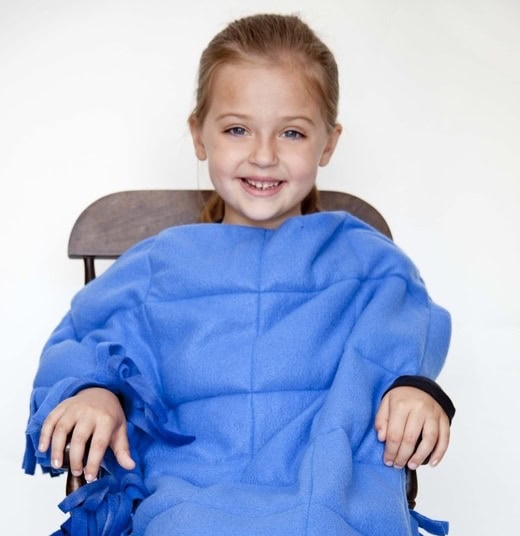This Is What the Research Says About the Use of Weighted Vests & Blankets for Autism, ADHD, & Anxiety

|
Getting your Trinity Audio player ready...
|
What Are Weighted Blankets and Vests Used For?
Working in public schools for over 10 years, I frequently saw occupational therapists utilizing weighted vests with students diagnosed with Attention Deficit Hyperactivity Disorder (ADHD) and Autism Spectrum Disorder.(ASD).
When I asked about the purpose of the vests, I was told that they have a calming effect because they give the wearer a sense of pressure. It is not uncommon for children on the autism spectrum or those with ADHD to have sensory needs, such as craving squeezes or deep pressure. I was also told that weighted vests can decrease anxiety and improve focus.
Recently I bought a weighted vest for work-out purposes. When I put on my 8-pound vest, I was amazed at the calming feeling that came over me. My anxiety eased and I felt more successful at just sitting still when I would sit with the vest on. Now I am contemplating ordering a weighted blanket.

Weighted vests and blankets are exactly what they sound like (blankets and vests with weight in them to make them a bit heavy).
What Does the Research Say About Weighted Vests and Blankets?
Being a school psychologist and behavior specialist, I frequently do research on products that aim to help individuals with ADHD, Autism Spectrum Disorder (ASD), anxiety, etc. So, I naturally wanted to see what the research had to say about weighted vests and blankets.
I was able to find some studies to substantiate the benefits of weighted vests and blankets; which I discuss below. However, I also think it is beneficial to review what the critics say, and the risks/hazards associated with weighted blankets/vests.
There are studies on the use of weighted blankets/vests with individuals with ASD (and other disabilities) that do not demonstrate beneficial effects or show mixed results, and the number of studies conducted are limited.
Additionally, in general, there is a lack of research regarding the most beneficial “amount of weight” to use on an individual and the length of time to have weighted blankets/vests on your body.
Precautions When Using Weighted Blankets
Weighted blankets/vests should never be used for discipline purposes and precautions must be taken when using them. On April 18th 2008, a weighted blanket led to fatal consequences for Gabriel Poirier, a nine-year-old student with autism spectrum disorder.
Gabriel was tightly wrapped from head to toe, in a weighted blanket by school staff, in an attempt to get him to stop making loud noises. A timer was set for 20 minutes at which point staff checked on him, and he was unresponsive.
A weighted blanket also led to suffocation when it was used in a day care on a 7 month old. Weighted objects are not recommended for children under three years old and should NEVER be used on children under one due to the risk of Sudden Infant Death Syndrome (SIDS).
It is advisable to consult with a healthcare professional before using a weighted item to ensure there is no medical reason to not use one.
More on the Research
Below are research-based studies on the use of weighted blankets and vests that demonstrate beneficial effects [studies are conducted on a variety of population types (e.g., anxiety, ASD, ADHD)].
Deep Touch Pressure
When the body receives deep touch pressure (DTP), it releases serotonin. Serotonin is a chemical in our bodies that promote relaxation. Interestingly some individuals with ASD are found to have low levels of serotonin.
People with anxiety, depression, Post Traumatic Stress Disorder, and Bipolar Disorder have also been known to have lower serotonin levels. Since applying pressure has shown to increase serotonin levels, weighted blankets and weighted vests are used to apply this pressure continuously for a period of time.

Lap pads and sensory body socks also can apply deep pressure.
Studies on Weighted Blankets
In one study, found in the Journal of Medical and Biological Engineering in 2012, patients with anxiety in dental environments used weighted blankets during treatment. Out of 15 patients in the study, all reported decreased anxiety while wearing the blankets during their dental procedures.
In another study conducted in 2012 by the Journal of Australian Psychiatry, patients, and clinicians in a psychiatric hospital reported significant reductions in patient distress and anxiety after using weighted blankets in a sensory room.
Related Article: What is a Sensory Room?
Another study from Occupational Therapy in Mental Health in 2008 found that out of 32 adults who used a weighted blanket, 63% reported lower anxiety after use, and 78% preferred the weighted blanket as a calming modality.
Additionally, a study from the Journal of Sleep Medicine and Disorders from 2015 found that weighted blankets helped 21/31 participants with insomnia fall asleep faster and achieve a more restful sleep.
If you or your child have an occupational therapist, consult with them on appropriate blanket (or vest) weight and usage. Here is an article with tips on how to determine appropriate blanket weight. 10 percent of the person’s body weight is a common recommendation for blankets, but reading the article will give a more thorough description of how to determine appropriate weight.
Weighted blankets are generally NOT recommended for children under 3 and should NEVER be used with children under one year of age as they can be a suffocation hazard!
Studies on Weighted Vests
In a 2001 study in the American Journal of Occupational Therapy, on-task behavior increased by 18% to 25% for all four students who participated in the study, while wearing a weighted vest. Additionally, three of the four students often asked to wear the vest other than during the observation times. This study should be interpreted with caution due to the small sample size.

Another study found in the South African Journal of Occupational Therapy in 2011, showed significant improvement of in-seat behavior, task completion speed, and attention to task while participants with ADHD wore weighted vests. 30 students participated in the study.
In a study found in the American Journal of Occupational Therapy in 2001, five children with ASD, utilizing a weighted vest, demonstrated improvements in attention to task and a decrease in self-stimulatory behaviors. A decreased number of distractions was the most consistent improvement observed. This study should be also interpreted with caution due to the small sample size.
What Do Occupational Therapists Say About Weighted Vests?
A 2004 report found in the US National Library of Medicine National Institutes of Health,, states that staying on task, staying in seat and attention span were the most common behaviors that therapists reported improving when weighted vests were used across diverse populations. These results are based on a survey completed by 349 occupational therapists. A follow up phone interview with 51 of the 349 therapists, confirmed the results of this study.
Please read the studies linked to in this article for a thorough understanding of the method, type of data collection, and any possible limitations.
How Does Sensory Processing Disorder Connect to Weighted Blanket Use?
Some occupational therapists report that weighted blankets and weighted vests are helpful for people with Sensory Processing Disorder. Sensory Processing Disorder is a condition in which the brain has trouble receiving and responding to information that comes in through the senses.
Sensory Processing Disdorder can be in addition to autism or ADHD. It can also stand alone, or be present with other conditions such as dyspraxia – a condition affecting motor coordination (e.g, running, climbing, jumping).
If you are concerned that you or your child has Sensory Processing Disorder or any other conditions, request an evaluation. You can go through their school to have their educational needs evaluated, or seek support from a provider in your community.
At the school level, occupational therapists can assess for sensory processing disorder whereas school psychologists can assess for ADHD, Autism, and other disabilities. Other clinicans, that can assess your child’s needs in the community include develomental pediatricians, child neurologists, and child psychologists.
See a variety of “deep pressure activities” at the OT Room.
Check out this video on how to make your own weighted blanket:
Due to the mixed results on the effectiveness of weighted items, it is important to work with a professional with experience, and use trial and error to determine what does or does not have a positive effect on you or your child.
Keep in Mind: Some individuals may dislike the feeling of deep pressure and have a negative reaction to weighted vests/blankets.
What are your thoughts and experiences on the use of weighted vests and blankets? Do you have anything to add to this article? Please comment below.
Thank you for visiting educationandbehavior.com. We are a free resource for parents/caregivers, educators, and counselors.






